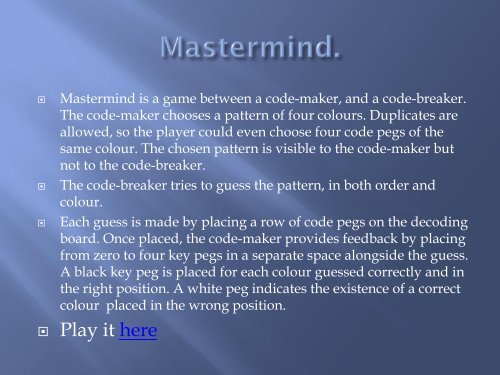(n-1) x
(n-1) x
(n-1) x
Create successful ePaper yourself
Turn your PDF publications into a flip-book with our unique Google optimized e-Paper software.
• Mastermind is a game between a code-maker, and a code-breaker.<br />
The code-maker chooses a pattern of four colours. Duplicates are<br />
allowed, so the player could even choose four code pegs of the<br />
same colour. The chosen pattern is visible to the code-maker but<br />
not to the code-breaker.<br />
• The code-breaker tries to guess the pattern, in both order and<br />
colour.<br />
• Each guess is made by placing a row of code pegs on the decoding<br />
board. Once placed, the code-maker provides feedback by placing<br />
from zero to four key pegs in a separate space alongside the guess.<br />
A black key peg is placed for each colour guessed correctly and in<br />
the right position. A white peg indicates the existence of a correct<br />
colour placed in the wrong position.<br />
• Play it here
In each of the following examples, you made your<br />
first guess as a code-breaker and received<br />
feedback from the code-maker.<br />
If your next guess takes thoroughly into account<br />
the information received so far, what are your<br />
chances that this second trial will be successful?<br />
Sometimes the code-maker cheats<br />
by giving hints which are<br />
impossible.
Two colours are in the right place, while two are not.<br />
1<br />
2
3<br />
4<br />
5
6<br />
7<br />
8
You are now the code-maker. There are 6 colours<br />
available. How many codes can you make:<br />
9) In a game with 3 slots, if you don’t repeat any<br />
colour.<br />
10) In a game with 4 slots, if you don’t repeat any<br />
colour.<br />
11) In a game with 5 slots, if you don’t repeat any<br />
colour.
12<br />
13<br />
14<br />
15
16<br />
17<br />
18<br />
19
20<br />
21<br />
22<br />
23
You are now the code-maker. There are 6 colours<br />
available. How many codes can you make:<br />
24) In a game with 4 slots.<br />
25) In a game with 5 slots if not all colours are the<br />
same.<br />
26) In a game with 4 slots, if you wish your code<br />
to be made of exactly 2 out of the 6 colours.<br />
27) In a game with 5 slots, if you wish your code<br />
to be made of exactly 2 out of the 6 colours.
You are code-breaker again. Count your chances of success in 1 move.<br />
28<br />
29<br />
30
• In 1977, the mathematician<br />
Donald Knuth, the father of<br />
the study of computer<br />
algorithms, demonstrated<br />
that the code-breaker can<br />
solve the pattern in five<br />
moves or less, using an<br />
algorithm that progressively<br />
reduced the number of<br />
possible patterns.
• Wikipedia entry on Mastermind:<br />
http://en.wikipedia.org/wiki/Mastermind_(board_game)<br />
• Play Mastermind online:<br />
http://www.puffgames.com/mastermind/<br />
http://www.web-games-online.com/mastermind/<br />
• Mathworld entry on Mastermind with additional links:<br />
http://mathworld.wolfram.com/Mastermind.html<br />
• UCC Enrichment information (Senior Cycle Students):<br />
http://euclid.ucc.ie/pages/MATHENR/index.html<br />
History and development of maths circles in the US:<br />
http://minerva.msri.org/files/circleinabox.pdf
• 1) 1 in 3 chances. Red can be swapped with any green.<br />
• 2) No chance -- the code-maker is cheating! 3 blacks+1 white<br />
=impossible.<br />
• 3) Impossible – any switch will keep at least two peg colours fixed.<br />
• 4) Impossible – any switch will keep at least two peg colours fixed.<br />
• 5) 2x2=4 ways to switch red with green. So ¼ chances.<br />
• 6) Impossible – only an even number of pegs can switch positions.<br />
• 7) 2x3=6 ways to switch red with green. So 1/6 chances.<br />
• 8) 2x4=8 ways to switch red with green. So 1/8 chances.<br />
• 9) 1/5 chances. Switch any green with blue or red, or switch blue<br />
with red.<br />
• 10) 1/6. In how many ways can you choose a subset of 2 colours<br />
out of the four colours = (4 choose 2)= 3+2+1=6.<br />
• 11) 1/10. (because (5 choose 2)= 4+3+2+1=10).
• 12) 1/15, because (6 choose 2)=15.<br />
• 13) 1/20, because you choose the wrong peg (4 choices) and<br />
replace it with another colour (5 choices, since you exclude the<br />
wrong one).<br />
• 14) 1/96, because you choose 2 wrong pegs out of 4 (6 choices),<br />
and replace each of them with another colour (4 choices each ,<br />
since you exclude the 2 wrong ones).<br />
• 15) 1/270, because you choose 3 wrong pegs out of 5 (10 choices),<br />
and replace each of them with another colour (3 choices each,<br />
since you exclude the 3 wrong ones).<br />
• 16)1/240, because 240=15x2^4.<br />
• 17)1/20 like in 13).<br />
• 18) 1/(1x5^2+5x4^2).<br />
• 19)1/(3x4^3+7x3^3).<br />
• 20)1/(6x3^4+9x2^4).<br />
• 21) 6^4.<br />
• 22) 6^5.<br />
• 23) (6 choose 2)x(4 choose 2)=90.
24) (6 choose 2)x (5 choose 2)=150.<br />
25)6x5x4.<br />
26)6x5x4x3.<br />
27)6x5x4x3x2.<br />
28)1/4 (one of the greens must be fixed=2 choices, in each case<br />
permute the other pegs keeping none fixed=2 choices).<br />
29)1/(4x(permutations of 3 pegs with no fixed peg))=1/8.<br />
30)1/ (permutations of 4 pegs with no fixed peg)=1/9.<br />
Permutations of 4 pegs with no fixed peg= 4x3x2-4x2-6-1=9.

















